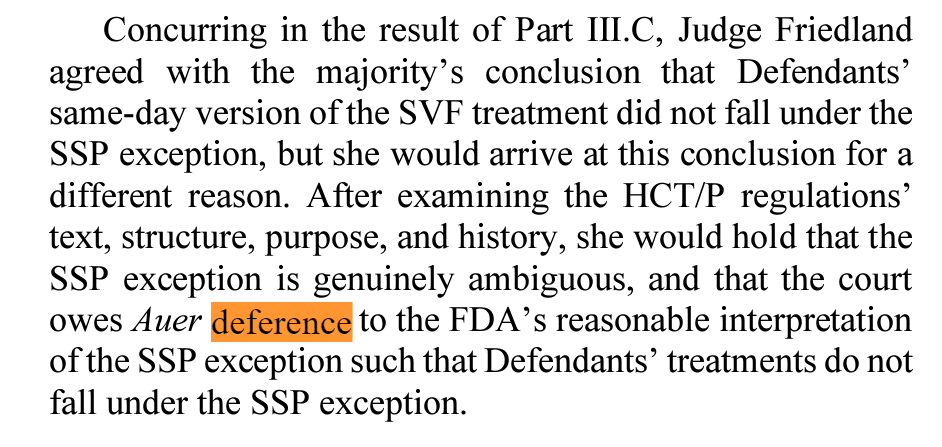9th Circuit Reverses California CSN Stem Cell Decision

One of the biggest factors causing the stem cell and exosome wild west to careen further out of control these past few years was the Bernal decision in California on the use of SVF and culture-expanded cells. The FDA lost this attempt at controlling these autologous treatments as drugs and appealed the case to the 9th Circuit, which unanimously reversed the decision yesterday. So, what does that mean for this space?
What’s Going On?
Cell Surgical Network (CSN) is a company that runs a provider network where physicians process the patient’s own adipose tissue by breaking it down into its cellular components. After rinsing and centrifuge steps, the resultant product is called Stromal Vascular Fraction (SVF). This is a mixture of cells, including a small percentage of mesenchymal stem cells.
Like culture-expanding autologous cells, the FDA has claimed in numerous cases that making SVF constitutes the manufacture of a drug that requires full clinical trials before approval. The agency successfully took down a company called US Stem Cell in court because it made SVF in doctor’s offices without FDA approval. When it came time to take down CSN, who was doing the same thing plus culturing cells through a third party, the FDA lost in the local district court. That judge, Jose Bernal, wasn’t buying that the FDA was authorized by congress to regulate a patient’s cells as a prescription drug. The FDA appealed that loss to the 9th circuit.
Yesterday, the 9th Circuit issued a unanimous decision that reversed the Bernal district court case. The 9th Circuit upheld the FDA’s right to regulate SVF and cultured cells as drugs requiring agency approval before use in patients.
What’s Behind this Stunning Uninamious Loss?
First, many years ago, the FDA drew a line in the sand called minimal manipulation. Any autologous tissue processed beyond simple rinsing, cutting, or centrifugation was considered a drug. For SVF, since the adipose tissue is digested with an enzyme, this product crosses that line and is in the drug category.
As I have written before, the FDA’s regulatory authority that allows them to consider a patient’s cells to be prescription drugs when that minimal manipulation line is crossed lives on shaky ground. That’s because this regulation was made by the agency and exceeded the authority granted by congress. Despite that weakness, the agency has benefited from a decades-old legal doctrine called Chevron. That rule gives all federal agencies deference in determining how their regulations should be interpreted.
Chevron has been like a football game where one side gets spotted three touchdowns and controls all the referees. It gives all federal agencies a huge leg up when a private citizen challenges one of its regulations. However, the Chevron doctrine was blown up in a seminal Supreme Court case called Looper Bright. So, how did the 9th Circuit reverse this case? Meet Auer Deference and “the mixture”.
Auer Deference
While the Chevron doctrine was the big brother in the world of challenging government regulations, its younger cousin is known as Auer Deference. In this case, the 9th Circuit still spotted the FDA three touchdowns and all of the refs by using Auer:

The issue was whether CSN should be permitted to challenge whether its SVF procedure fits under 21 CFR 1271.15(b) Same Surgical Procedure Exemption (SSE), which could excuse the fact that it crossed the minimal manipulation line. Here, the minority 9th circuit opinion used Auer like it would have used the now-extinct Chevron deference.
In the majority opinion, they just followed the FDA’s interpretation of the SSE without using Auer to analyze whether the FDA’s interpretation of the SSE or CSN is correct.
Is this minority opinion important?
Auer and Kisor
While I know that all of this is getting into the legal weeds, it’s important to note that Auer deference was recently weakened by a case called Kisor v Wilke. In addition, when SCOTUS took down Chevron, there was an open question of whether it also gutted Auer at the same time. Remember this factoid, as it will become important if CSN decides to appeal to SCOTUS.
“The Mixture”
Every regulatory case needs a “hook” that allows that agency to assert authority. For a product that is manufactured in one state in a doctor’s office, the feds need to be able to show that the product traveled in what’s called “interstate commerce.” Here, that hook is “the mixture.” Basically, the 9th Circuit determined that the FDA had standing in interpreting SVF as a drug because it was a mixture of various components:

Why is this important? This allowed the 9th Circuit to tie this case back to the Regenerative Sciences case (where the FDA also won its authority to classify autologous tissues as a drug), where the hook was that culture-expanded cells were mixed with other items (i.e., an antibiotic). If any of those items traveled in interstate commerce (like the collagenase used to digest the fat), then the feds have authority over the SVF made only in California.
SCOTUS?
Remember when I said the loss of Chevron would make the stem cell wild west crazier? I predicted that it would take years for this loss to be felt. Since then, it’s become clear to me that we’re about to have the same judicial divide as the one we see in our politics. Meaning left-leaning jurisdictions like California will find ways to keep the idea of deference alive as they believe in a powerful federal government. Right-leaning jurisdictions will have no problem weakening the power of the federal agencies by cheerfully throwing out deference and allowing private citizens to take potshots at federal regulations.
In my opinion, this is just what happened here. The California circuit court opinion found a way to thumb its nose at SCOTUS for eliminating Chevron deference. The majority didn’t even need deference tests like Chevron or Auer; they just sided with the FDA’s interpretation of the SSE.
My Thoughts?
When we challenged the FDA’s regulatory authority over calling autologous cells drugs, my youngest son was in elementary school. That was such a long time ago that now he’s a Junior in college. I had expected a rational physician-led cell therapy industry that would look like the IVF space. Doctor’s using professional organizations in a rational way to control care offerings and help patients. Instead, we got an out-of-control stem cell wild west that hurts more people than it helps. Hence, while a decade+ ago, I would have cheered Bernal and been concerned about the 9th circuit regulatory overreach; I’m in the opposite camp now. I applaud the FDA’s win here.
The Future and a Divided Country?
This divide over whether federal agencies should be able to block challenges to their regulations will likely create two parts of the United States concerning stem cell regulation. Conservative-leaning states and circuits will likely allow these challenges, whereas more left-leaning states will block them. In essence, we could end up with states where the power of the FDA to regulate stem cells as drugs is limited and states where it’s absolute. We already see that with Utah’s new law, which challenges the FDA’s regulatory authority not in the courts, but legislately. IMHO, the inevitable conclusion of that divide will be a stem cell case that makes it to the Supreme Court. That case may actually test whether the federal agencies get any deference.
The upshot? The 9th circuit may have left a ball sitting on a tee for SCOTUS. Will CSN spend hundreds of thousands to millions to bring this case to the Supreme Court, and will SCOTUS use this case to get rid of Auer? Will this CSN loss finally begin to tame the stem cell wild west? In the meantime, I suspect we will see more aggressive regulatory action going forward on SVF and culture-expanded cells. I also suspect that we will see stem cell scammers realize they may get away with much more if challenging the agency in Mississippi or Utah than in California.

NOTE: This blog post provides general information to help the reader better understand regenerative medicine, musculoskeletal health, and related subjects. All content provided in this blog, website, or any linked materials, including text, graphics, images, patient profiles, outcomes, and information, are not intended and should not be considered or used as a substitute for medical advice, diagnosis, or treatment. Please always consult with a professional and certified healthcare provider to discuss if a treatment is right for you.
